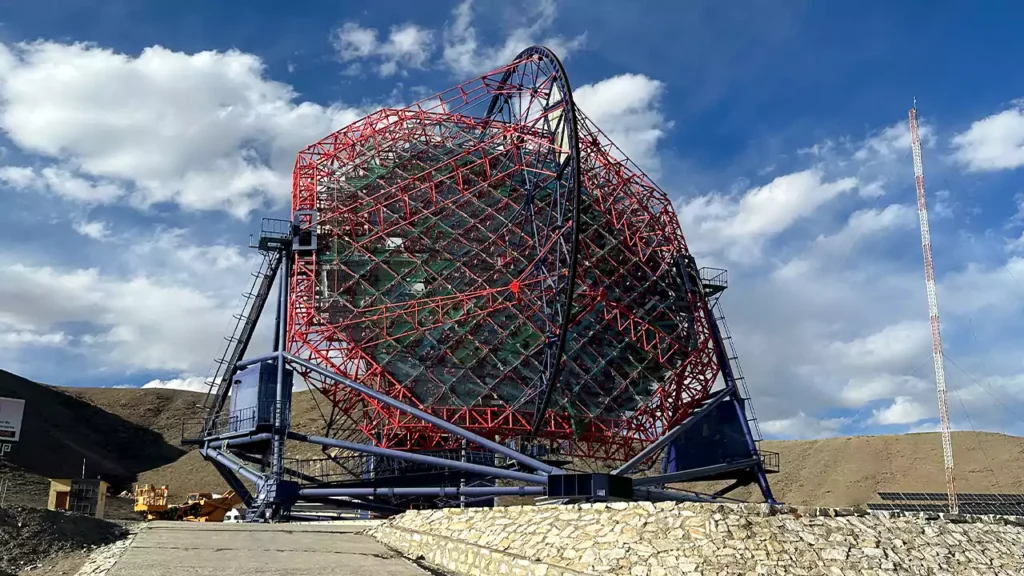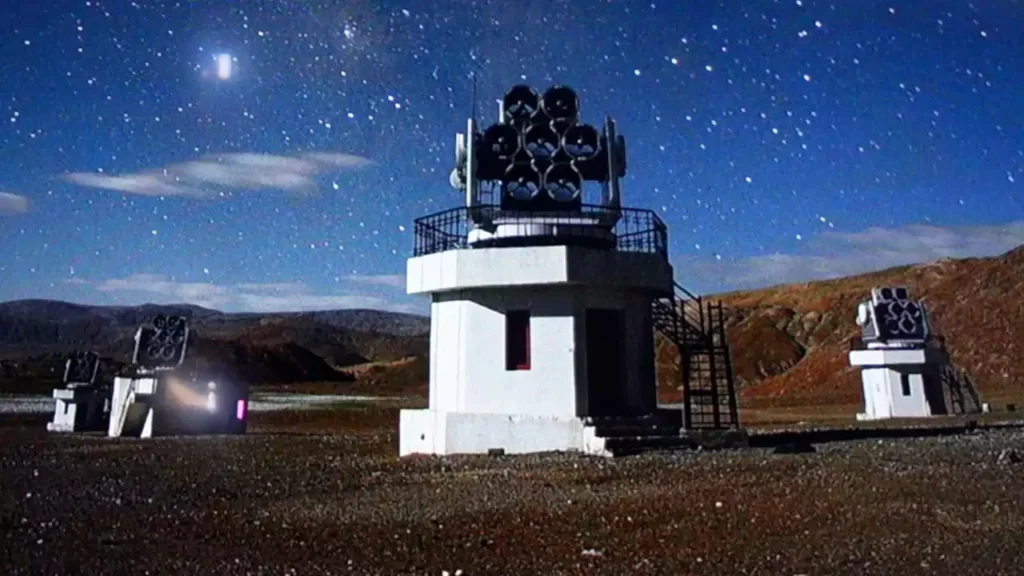Hanle Observatory officially known as IAO (Indian Astronomical Observatory) is a High Altitude field station of IIA (Indian Institute of Astrophysics) Bangalore located in Hanle and has been operational since Sept 2000.
Hanle is 270Kms from Leh 4500 Mtr (14764 feet) above sea level.
IAO is the 2nd Highest Observatory for optical and infrared astronomy.
It is considered to be One of the Highest Astronomical observatories in the world.
Why Indian IIA selected Hanle for an Astronomical site?
Astronomical sites cannot be near by city lights as city light will interfere with astronomical lights.
Atmospheric particle/content are more at lower altitude like water vapors, dust, smoke and industrial by product gasses etc. which obstructs light coming from celestial objects.
Annual precipitation level is crucial, astronomical site required very low precipitation level so more no of clear sky nights in a year – 260per year.
Astronomical site should not be too far away from human inhabitant, compromised with cost of infrastructure developments and survival.

Different Telescopes or Observatories at Hanle
Himalayan Chandra Telescope (HCT)
This 2-meter behemoth, named after renowned Indian astrophysicist Subrahmanyan Chandrasekhar, isn’t just an instrument; it’s a gateway to understanding the universe’s deepest secrets.
Equipped with advanced instruments like the Himalayan Faint Object Spectrograph Camera (HFOSC) and the Near-infrared camera, the HCT can capture stunning images and gather valuable data across a wide range of wavelengths. Astronomers from around the world can remotely operate the telescope from the Centre for Research & Education in Science & Technology (CREST) in Hosakote, Karnataka, making it a truly collaborative platform for astronomical research.
The HCT is a testament to India’s growing prowess in astronomy. It has not only deepened our understanding of the universe but also inspired a generation of young scientists to reach for the stars. As it continues its vigil, perched atop the world, the HCT promises to unlock even more cosmic secrets in the years to come.

Growth Telescope
Unlike its monumental neighbor, the Himalayan Chandra Telescope, GROWTH takes a different approach, specializing in the fleeting drama of the universe: explosive transients and variable sources.
Imagine a telescope that doesn’t just stare at the heavens, but reacts to them. That’s GROWTH. This fully robotic marvel is part of a global network of telescopes, constantly scanning the night sky for short-lived celestial fireworks. Supernovae, gamma-ray bursts, erupting stars – none are too fast or faint for GROWTH’s sharp gaze.
But what makes Growth Telescope special?
- Speed: Unlike traditional telescopes, GROWTH is automated, able to react to transient events within seconds. This precious head start allows astronomers to capture the crucial early stages of these phenomena, often hidden from slower telescopes.
- Global Network: GROWTH isn’t alone. It’s part of a worldwide relay race of observatories, spread across different continents. When one telescope spots a transient, it instantly alerts the others, allowing for multi-wavelength observations from different corners of the globe. This unified vision paints a much richer picture of the event, unveiling its secrets like layers of an onion.
- Focus on Time: GROWTH delves into the realm of time-domain astronomy, studying objects that change rapidly. This opens up a whole new dimension of celestial understanding, from the explosive deaths of massive stars to the flickering dance of variable stars.

Mace Telescope
MACE stands for (Major Atmospheric Cherenkov Telescope) it is Gamma ray Telescope which is installed in Hanle, This telescope is managed by Bhabha Atomic Research Centre.
This behemoth, with its 21-meter diameter dish resembling a giant’s eye scanning the heavens, isn’t your typical stargazer. MACE specializes in detecting a different kind of light – the fleeting, ethereal glow of high-energy gamma rays.
Imagine cosmic particles, like cosmic rays and pulsars, traveling at mind-boggling speeds and colliding with Earth’s atmosphere. These collisions create a cascade of charged particles, which in turn emit Cherenkov radiation, a faint blue light that streaks across the sky in an instant. MACE, with its array of mirrors and photomultiplier tubes, is designed to capture these fleeting flashes, offering a glimpse into the universe’s most energetic phenomena.

Hagar Telescope or Observatory
HAGAR stands for High Altitude Gamma Ray Observatory where each telescope in HAGAR consist of 07 paraxially mounted parabolic mirrors, it was operational in the year 2008.
HAGAR doesn’t gaze at the cosmos through visible light, but listens to its high-energy symphony – the language of gamma rays.
Imagine celestial giants like supernovas and pulsars, flinging cosmic rays like celestial bullets. When these bullets slam into Earth’s atmosphere, they unleash a fleeting, ethereal glow – Cherenkov radiation. HAGAR, with its seven watchful eyes spread across the sky, hunts for these fleeting whispers of the universe’s most violent events.

Organizations at IAO Hanle
- Indian Institute of Astrophysics HCT & GROWTH
- Tata Institute of Fundamental Research, HAGAR
- Bhabha Atomic Research Centre, MACE
- Small Experiment by ISRO, DRDO
Celestial Object observed through Himalayan Chandra Telescope (HCT)

Foundation of Indian Astronomical Observatory
Hanle observatory or Indian Astronomical Observatory is an High Altitude astronomy sites which is operated from Bengaluru IIA (Indian Institute of Astrophysics).
The observatory is located in the region which is known as DIGPA RATSA RI which stands on Mt. Saraswati.
The foundation stone for the observatory is laid by General K.V Krishna Rao, PVSM (Retd.) which was then the Governor of Jammu & Kashmir on 16th October 1997.
Interesting Things to Know about Hanle Observatory
- It is an observatory which is located in High Altitude Region which makes it special.
- It is one of the world highest sites for Infrared, gamma and optical telescopes.
- The observatory is handled by the IIA Bengaluru.
- The HCT (Himalayan Chandra Telescope) and the Dome Rotate 360 Degrees.
- In Hanle everyday light goes off around 2000 Hrs. so that clear sky can be seen without any disturbance.
- Hanle is also known as Meteorite village because of Astronomical observatory.
- Hanle Observatory is stands in Mt. Saraswati.
Power source at Indian Astronomical Observatory
Hanle being the High Altitude region this place is ideal for solar energy as the intensity of sunlight is high and no of clear skies is more.
Presently 90KW of peak generation is dedicated to the observatory, 30KW of 3 Unit. use Diesel Generator for backup.

Who takes care of the Observatory?
There are mainly the local people those who take care of the observatory and which are in direct contact with IIA Bengaluru, The data collected by the telescopes and observatory is processed from Bengaluru.
Captured with the Phone 12: A Midnight Still Life

Frequently Asked Questions
-
Name the Telescope and observatory in Hanle?
There are various agencies work together to collect the data especially the IIA Bengaluru and the main telescope is HCT (The Himalayan Chandra Telescope) then Growth Telescope, Mace Telescope and last Hagar observatory.
-
What is the best time to visit the Hanle Observatory?
The best time considers to visit the observatory is from March to October as during winter the temperature drops down to -20 Degrees which makes it difficult.
-
Why is Hanle Observatory is special?
There are 4 main reasons which makes Hanle special for observatories.
1) Exceptional Sky Conditions
2) Diverse Telescope Array
3) Pioneering Research & Discovery
4) Cultural Significance & Eco-tourism -
Hanle Observatory is also known as?
Hanle observatory is also known as IAO (Indian Astronomical Observatory).
-
How far is Hanle Observatory from Leh?
Hanle is at a distance of 270 Km from Leh.
-
What is the procedure to visit the Hanle Indian Astronomical Observatory?
You can visit the observatory during non working hours during morning as it opens up at 10 in the morning.
-
How much is the price of ticket for Hanle Observatory?
Visiting the observatory is free of cost no fees is charged if you are planning your visit please visit after 10 am during odd hours nobody is allowed to visit the observatory.
-
Is videography or Photography is allowed in Hanle Observatory (IAO)?
Yes, if you want to take picture or capture a video there are no restriction but when they are explaining you how it works then it is not allowed.
-
Hanle is also known as?
Hanle is also known as Meteorite Village of India.
-
What else can be covered while you are in Hanle?
You can visit the one of the oldest monastery of Hanle, which is a famous tourist sightseeing places.
-
Do we require permit for visiting Hanle?
No, permit is not required but you have to pay an environment fee and register yourself on official website if you are visiting Hanle.
Web Stories
Hanle Videos
Joshi Milestoner is a website working continuously to deliver the best on travel, adventure and airports & aviation. Do not forget to read our blogs and for any queries you can write to us our team will be happy to help you.
Get notified of our blog post via email by subscribing to our Newsletter with the link provided below and do consider subscribing our YouTube channel (Joshi Milestoner) too for more you can follow us on Google News.
Affiliate Disclosure / Disclaimer: Blog Post on our website may contain affiliate links/ Banner. By Clicking and by purchasing the commission can be earned by us (at no extra cost to you) if you purchase anything through the links provided on this website.




